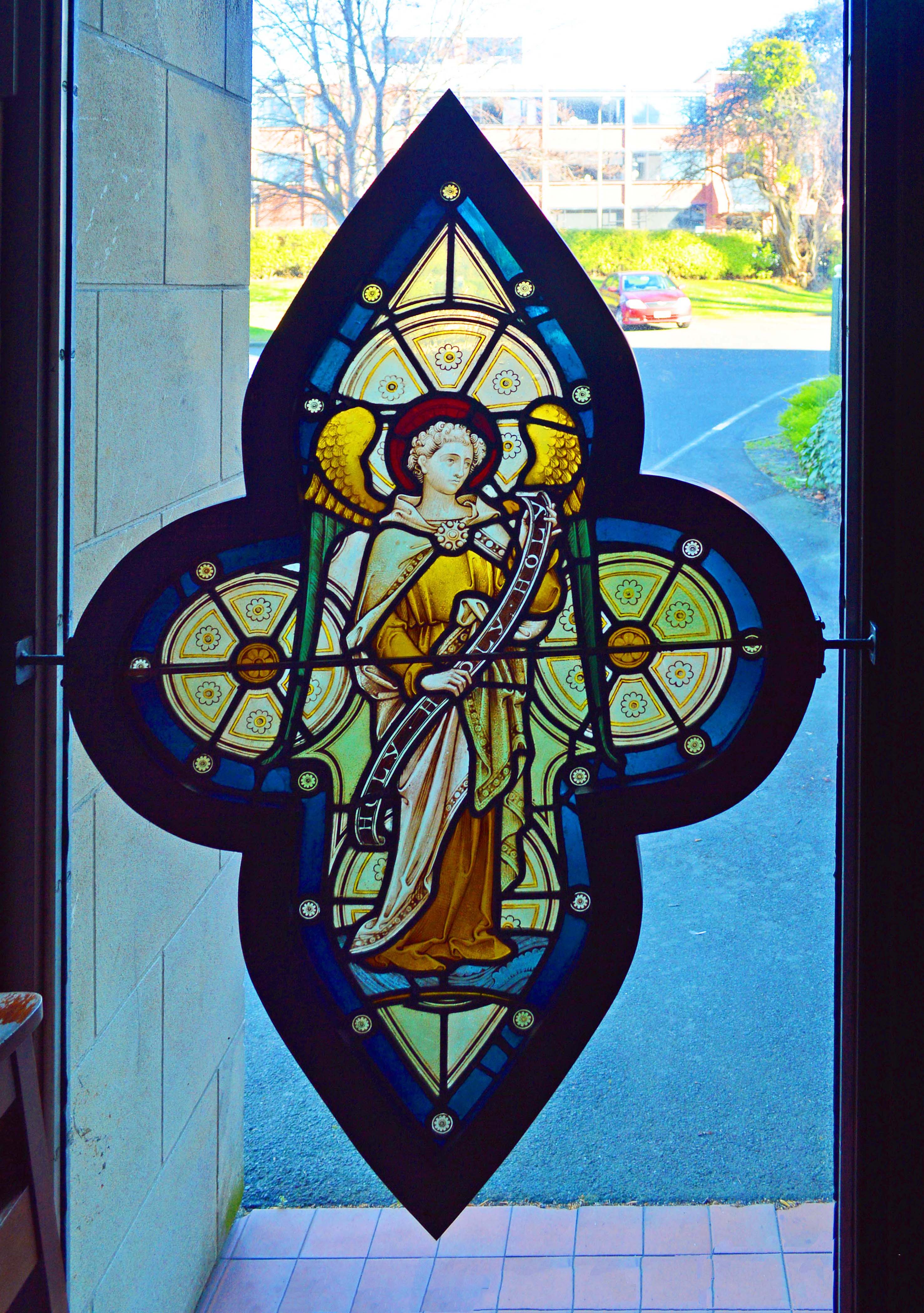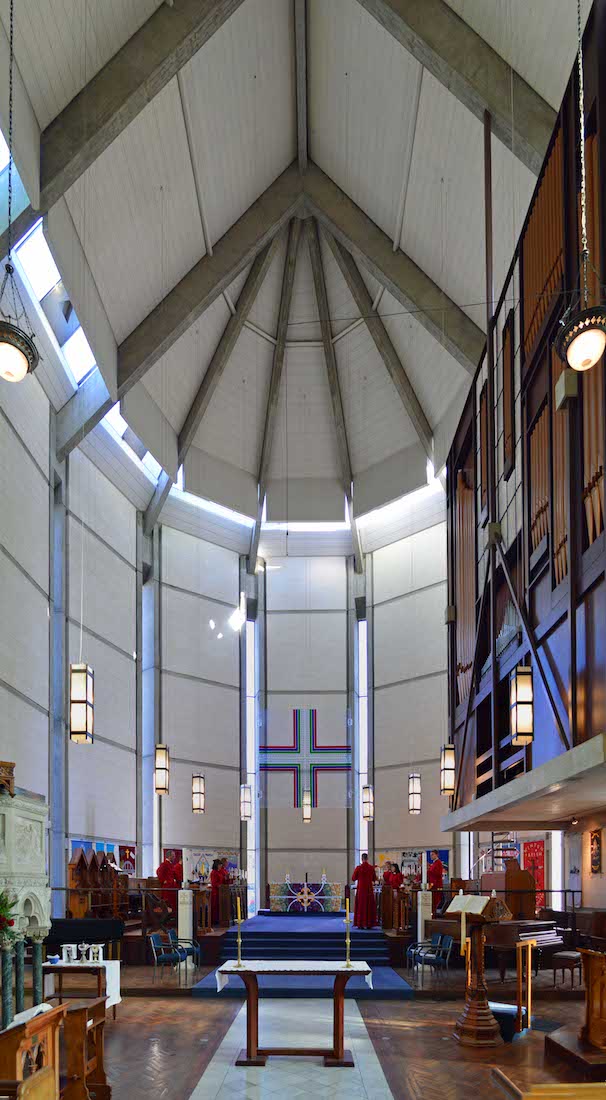
We emerge from the crypt back into the nave, appreciating once more the towering arches and lofty space. PLAN
42. RECALLING THE NAVE VIEW TO THE APSE

And again we stand at the back of the nave, but now our attention is focused towards the apse. Closest are the pulpit, the lectern and the cathedra.
43. PULPIT
The steps up to the pulpit are made of light marble and the pulpit, from which the gospel is proclaimed, stands on slender columns of West Coast green marble (‘pounamu’). A Canterbury Cross can be seen on the near stair rail. The pulpit’s alabaster panels, carved by George Frederick Guernsey, depict scenes from the life of Christ.
44. PULPIT DETAILS
From left, the scenes depicted around the pulpit are: Christ’s childhood (the carpenter’s shop at Nazareth); his teaching ministry (parable of the sower); his healing ministry (the raising of Lazarus), and the resurrection. A further (initial) panel, not pictured here, shows the birth of Christ (the visit of the wise men).
45. LECTERN
Across from the pulpit is the lectern which is used for the reading of the Scripture. This lectern is made of kauri and is a memorial to Dean Cruickshank. The revolving top has two bookrests, one for the Old Testament and the other for the New Testament. On the ends are replicas of the Canterbury Cross and a Cornish Pastoral Cross.
46. CATHEDRA
The Bishop’s throne is made of Southland beech. The presence of this throne, called ‘cathedra’ in Latin, indicates that the bishop of the diocese is centred here. This is what gives this church the name ‘cathedral’. The crest on the cushion is that of the Diocesan Synod.
47. DEAN’S STALL
Nearby is the Dean’s stall. The cushion here remembers Alfred Fitchett who was Dean of Dunedin Cathedral from 1894 to 1929, and his son William who was Bishop of Dunedin 1934–1952.
48. APSE
Finally we turn our attention to the apse. As we have seen, this was added to the old building between 1969 and 1971. The central aisle leads up to the high altar with choir stalls on either side, and the large organ to our right. Above hangs the perspex cross with stripes of the liturgical colours.
49. ORGAN
The Cathedral organ, one of the largest and finest in New Zealand, was built in 1919 by Henry Willis III, in London and was installed the following year. In 1972, it was entirely rebuilt and repositioned by the South Island Organ Company of Timaru. There are four manuals – great, swell, choir and solo. The organ of St Paul's has more than 3500 pipes and is often used for civic performances.
50. ACROSS THE APSE
From our position under the organ, we look across to the North wall of the apse. The apse walls are tall and bare, partitioned by floor to ceiling strip windows with plain glass. Around the bottom of the walls is a busy horizontal strip of banners from some of the 33 churches of the Diocese – a transition between the plain walls of the apse and the more ornamented Gothic nave?
51. NORTH AMBULATORY
We walk around the apse ambulatory from the North, checking out the banners. So here there is a board listing the Deans of the Cathedral, and from the left, banners representing: • All Saints, Tapanui; • Holy Trinity, Gore; • Holy Trinity, Port Chalmers; • St John’s , Milton; Holy Trinity, Lawrence; St Paul, Kaitangata; • St Michael & All Angels, Otago Peninsula.
52. NORTHEAST AMBULATORY
The banners displayed here are from left: • St Andrew’s, Cromwell; • St Nicholas, Waverley; • St Saviour’s, Matura; • St Luke’s, Oamaru; • Taieri Parish; • Wakatipu.
53. SOUTHEAST AMBULATORY
The banners continue ... . From left: • The Dunedin Parish; • St Paul’s Cathedral; • St John’s, Roslyn; • All Saints’, Dunedin; • Waimea Plains; • Winton Parish. The far light-blue banner behind the spiral staircase reads ‘The Church by the (Bridge)’, and refers to All Saints’, Invercargill.
54. SOUTH AMBULATORY
The general view of this section is restricted by the organ above and its spiral staircase. From left we have the banner for Holy Trinity, North Invercargill; • a board listing the Cathedral bishops from S. T. Nevill to the present time; and the general view. The remaining board gives a list of Cathedral organists. We now complete our tour by approaching the ‘high altar’ at the Eastern end of the apse.
55. HIGH ALTAR
This is the communion table and is made of Southland beech. The altar frontal covering it was designed by parishioner Robin Aitkin in 2006. The theme is ‘Peace in our Troubled World’. It has a gold Canterbury Cross and colours representing the liturgical colours of the Christian year. This completes our tour of St Paul’s.
CONCLUSION
I hope you have enjoyed visiting St Paul’s Cathedral, Dunedin with me. The Cathedral is interesting, and we found the congregation friendly when we attended Choral Eucharist here.
I am happy to receive constructive comments or corrections concerning this website. The best websites are the ones which have no errors! I am grateful to my wife Margie who came to Dunedin with me, and who has proof-read these pages.
The photographs on this site are all mine, but I take little credit for the text. I found Wikipedia helpful as always, and St Paul’s has a wonderful collection of helpful written material.
The Cathedral has a website with link:
The photographs which appear on this site can also be found in higher resolution at:
https://www.flickr.com/photos/paulscottinfo/sets/
Paul Scott Site created 11/ 2018 ; reformatted 07 / 2020














